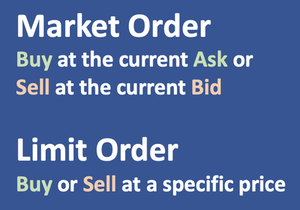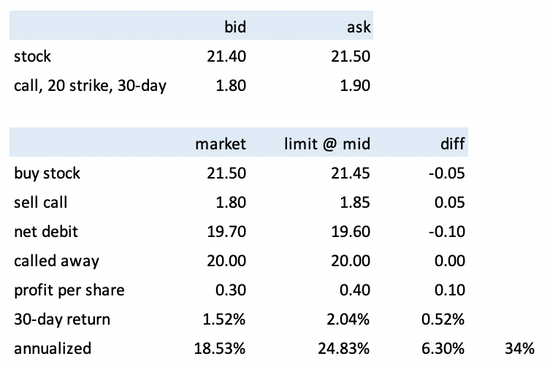Improve Returns With Limit Orders
Want to earn 6% more yield each year? Read on...
Stocks and options don't have a single price; they have two: a bid and an ask. The bid price is the price you will receive if you place a market order to sell. The ask price is the price you will pay if you place a market order to buy. You can normally do better than a market order by placing a limit order at the midpoint between the bid and ask.
Limit Order To Sell
For covered call investors, selling a call option is one of the most common transaction types. Many investors do it every week for each stock position they have. When applied to a large number of trades (or even a single trade with a large number of contracts) you can make more money by using a limit order to sell instead of a market order to sell.

Example of Market Order vs Limit Order
Say a stock you like has a market of 21.40 x 21.50. That means the current bid is 21.40 and the current ask is 21.50.
Now let's say there is an option (strike of 20) you want to write on that stock, and the option is currently trading at 1.80 x 1.90 and expires in 30 days.
If you use market orders to buy the stock and sell the call then you will pay 21.50 for the stock and receive 1.80 for selling the call, for a total net debit of 19.70.
But, if you use limit orders for both legs and get filled at the midpoint then your cost to buy the stock is 21.45 and sell the option is 1.85, for a net debit of 19.60; which is 10 cents better than the market order case.
10 Cents? Who Cares?
You should care. Because if this stock is called away at 20 then:
- Market order profit 20 - 19.70 = 0.30 per share
- Limit order profit: 20 - 19.60 = 0.40 per share
And returns:
- Market order return: 0.30 / 19.70 = 1.52%
- Limit order return: 0.40 / 19.60 = 2.04%
That's a 0.52% increase in return, which is 34% better than 1.52%. And if you annualize this 30-day trade:
- Market order annualized return = 18.5%
- Limit order annualized return = 24.8%
So you can do 6.3% better on an annual basis by using limit orders. If you have $100K account that's an extra $6300 per year (more impressive than 10 cents per share on one trade; and shows that these tiny bits add up when applied at scale).

Tips When Placing A Limit Order
Just because you use limit orders to sell at the midpoint of the current bid and ask does not mean you will get filled at that level. It usually does, but not always. You may have to either (1) be patient (for like half a minute), or (2) work the order and give up a little to get it filled.
Here's what we mean by working the order. Say the bid/ask is 1.80 x 1.90 and you place a limit order to sell at 1.85. Now you wait… 15 seconds have gone by and you're not filled. Then 30 seconds. Now you're worried about the underlying stock moving and changing the bid/ask of the call option you're trying to sell.
So, you Update or Edit the limit order and change it by 1 penny. Now it's a limit order to sell at 1.84 (was 1.85). That's usually enough to get a fill, but it depends on how active the contract is that you're trying to sell (and also if the underlying stock has moved in the last 30 seconds). You may have to move the limit down another penny to 1.83, and so on, until you are eventually filled.
Once in a while the underlying security moves against you while you're trying to optimize the option sale at the midpoint. But most of the time you will get a better fill by selling with limit orders. If you improve your fill on 4 out of 5 trades (or even 3 out of 5) then you're still ahead when compared to using market orders on everything.
Don't Be Lazy With Market Orders: Nickels Add Up
If the average bid-ask spread is 10 cents wide and if you can get filled at the midpoint all year, then you've just made an extra 5 cents times the number of shares you trade in a year.
Same thing with options except you have to multiply by 100. So, if you sell 50 contracts/month that's 600 in a year. If you save a nickel on each limit order you use, that's 0.05 * 600 * 100 = $3000/year in extra profit, merely because you switched from a 'market order to sell' to a 'limit order to sell' to get a 5 cent improvement in your fills.
Mike Scanlin is the founder of Born To Sell and has been writing covered calls for a long time.
